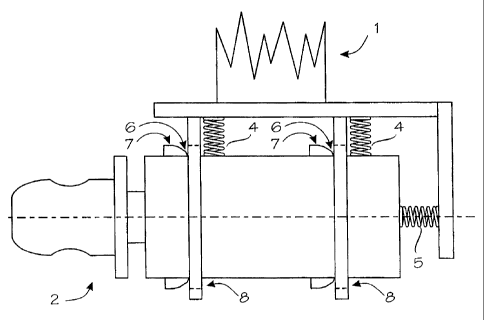Une partie des informations de ce site Web a été fournie par des sources externes. Le gouvernement du Canada n'assume aucune responsabilité concernant la précision, l'actualité ou la fiabilité des informations fournies par les sources externes. Les utilisateurs qui désirent employer cette information devraient consulter directement la source des informations. Le contenu fourni par les sources externes n'est pas assujetti aux exigences sur les langues officielles, la protection des renseignements personnels et l'accessibilité.
L'apparition de différences dans le texte et l'image des Revendications et de l'Abrégé dépend du moment auquel le document est publié. Les textes des Revendications et de l'Abrégé sont affichés :
| (12) Brevet: | (11) CA 2349254 |
|---|---|
| (54) Titre français: | SYSTEME D'ENROULEMENT DE CABLES OU ANALOGUES |
| (54) Titre anglais: | ARRANGEMENT FOR WINDING CABLES OR THE LIKE |
| Statut: | Périmé |
| (51) Classification internationale des brevets (CIB): |
|
|---|---|
| (72) Inventeurs : |
|
| (73) Titulaires : |
|
| (71) Demandeurs : |
|
| (74) Agent: | CASSAN MACLEAN IP AGENCY INC. |
| (74) Co-agent: | |
| (45) Délivré: | 2007-07-24 |
| (86) Date de dépôt PCT: | 1999-11-11 |
| (87) Mise à la disponibilité du public: | 2000-05-25 |
| Requête d'examen: | 2004-08-23 |
| Licence disponible: | S.O. |
| (25) Langue des documents déposés: | Anglais |
| Traité de coopération en matière de brevets (PCT): | Oui |
|---|---|
| (86) Numéro de la demande PCT: | PCT/FI1999/000937 |
| (87) Numéro de publication internationale PCT: | WO2000/029316 |
| (85) Entrée nationale: | 2001-05-01 |
| (30) Données de priorité de la demande: | ||||||
|---|---|---|---|---|---|---|
|
L'invention concerne un système de bobinage et de débobinage d'un câble ou analogue sur un touret comportant un trou central. Le système comprend deux bras de support (1) sensiblement verticaux, mobiles, qui sont maintenus par un cadre. Les extrémités libres desdits bras sont dotées de mandrins (2) destinés à être introduits dans les trous centraux du touret (3) entre les bras de support se déplaçant l'un vers l'autre. Le touret peut ainsi être soulevé de la base au moyen d'un ajustement vertical des bras de support (1) permettant l'enroulement. Afin d'obtenir une structure simple, les mandrins (2) sont montés flottants aux extrémités des bras de support (1), ce qui permet aux mandrins (2) de se déplacer librement dans différentes directions. Les bras de support, qui se déplacent l'un vers l'autre et qui s'appuient contre le trou central du touret (3), provoquent le déplacement axial des mandrins (2) par rapport aux bras de support (1) en une position dans laquelle les mandrins (2) se retrouvent bloqués contre les bras de support (1).
The invention relates to an arrangement for winding a cable or the like on and
off a reel with a centre hole, which arrangement
comprises two movable, substantially vertical support arms (1), which are
supported by a frame structure and the free arm ends of which are
provided with spindles (2) arranged to be inserted to the centre holes of the
reel (3) between the support arms, when the support arms (1)
are being moved towards one another, whereby the reel can be raised from the
foundation by means of vertical adjustment of the support
arms (1) to enable the winding. To achieve a simple structure, the spindles
(2) are arranged floatably to the ends of the support arms (1)
allowing the spindles (2) to move freely in different directions. As a result
of the support arms moving towards one another and resting
against the centre hole of the reel (3), the spindles (2) are arranged to move
axially with respect to the support arms (1) into a position in
which the spindles (2) are locked to the support arms (1).
Note : Les revendications sont présentées dans la langue officielle dans laquelle elles ont été soumises.
Note : Les descriptions sont présentées dans la langue officielle dans laquelle elles ont été soumises.

Pour une meilleure compréhension de l'état de la demande ou brevet qui figure sur cette page, la rubrique Mise en garde , et les descriptions de Brevet , États administratifs , Taxes périodiques et Historique des paiements devraient être consultées.
| Titre | Date |
|---|---|
| Date de délivrance prévu | 2007-07-24 |
| (86) Date de dépôt PCT | 1999-11-11 |
| (87) Date de publication PCT | 2000-05-25 |
| (85) Entrée nationale | 2001-05-01 |
| Requête d'examen | 2004-08-23 |
| (45) Délivré | 2007-07-24 |
| Expiré | 2019-11-12 |
Il n'y a pas d'historique d'abandonnement
Les titulaires actuels et antérieures au dossier sont affichés en ordre alphabétique.
| Titulaires actuels au dossier |
|---|
| MAILLEFER S.A. |
| Titulaires antérieures au dossier |
|---|
| LAUHDE, MIKA |
| NEXTROM HOLDING S.A. |
| SPIRT AVERT AG |